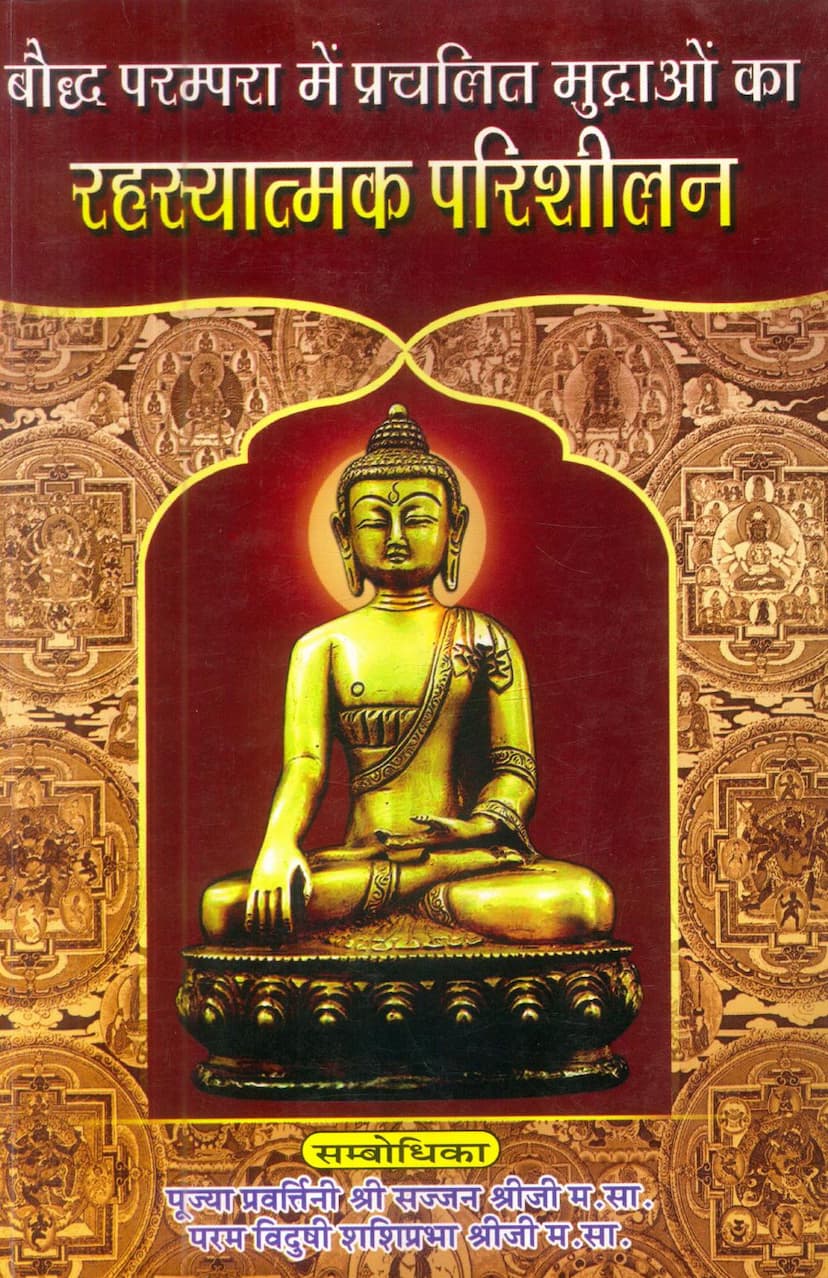Bauddh Parampara Me Prachalit Mudraoka Rahasyatmak Parishilan
Added to library: September 1, 2025

Summary
Here's a comprehensive summary of the Jain text "Bauddh Parampara Me Prachalit Mudraoka Rahasyatmak parishilan" by Saumyagunashreeji, based on the provided pages:
Book Title: Bauddh Parampara Me Prachalit Mudraoka Rahasyatmak parishilan (Mystical Examination of Gestures Prevalent in the Buddhist Tradition)
Author: Dr. Sadhvi Saumyaguna Shri
Publisher: Prachya Vidyapith (under the Sajjanmani Granthamala publication)
Overview:
This book is a D.Litt. thesis presented for a degree, focusing on a comparative and critical study of gestures (mudras) prevalent in the Buddhist tradition within the framework of Jain ritualistic practices and overall religious traditions. The author, Sadhvi Saumyaguna Shri, under the guidance of Dr. Sagarmal Jain, presents a comprehensive, scientifically and spiritually grounded analysis of various mudras, highlighting their mystical significance, therapeutic benefits, and historical context.
Key Themes and Content:
-
Comparative and Critical Study: The core of the work lies in comparing and critically examining the gestures used in the Buddhist tradition with those found in Jainism, Hinduism, Yoga, and even contemporary medical practices. The author emphasizes the universal and timeless relevance of mudras.
-
Mystical Significance of Mudras: The book delves into the profound, often hidden, meanings and powers of mudras. It explains how these gestures, particularly those involving the hands, are seen as controlling mechanisms for the human body, capable of bringing about significant physical, mental, intellectual, and spiritual transformations without external aid.
-
Therapeutic and Health Benefits: A significant portion of the book is dedicated to the practical applications of mudras in health and well-being. It details how specific mudras can balance the five elements (earth, water, fire, air, ether) within the body, which are believed to be represented by the fingers. The text lists numerous ailments and the corresponding mudras that can help alleviate them, ranging from common issues like insomnia and digestive problems to more complex conditions. It also touches upon acupressure points and their connection to mudras.
-
Chakras and Glands: The book establishes a strong link between mudra practice and the activation and balancing of the body's seven chakras (Muladhara to Sahasrara) and various endocrine glands. It explains how mudras influence these vital energy centers and glands, leading to physical and psychological harmony.
-
Buddhist Mudras: The book provides detailed descriptions and illustrations of numerous Buddhist mudras, categorizing them into several sections:
- Five Main Mudras of Lord Buddha: These are presented as central gestures associated with significant events or teachings of Buddha.
- Forty General Mudras of Lord Buddha: A detailed exploration of various other mudras attributed to Buddha, often described with their Thai or Indian names and associated meanings.
- Mudras Related to the Seven Jewels (Saptaratna): Explores mudras connected to the symbolic seven treasures in Buddhist tradition.
- Mudras Related to the Eight Auspicious Symbols (Ashtamangala): Discusses mudras associated with these auspicious symbols.
- Mudras Related to the Eighteen Duties (Ashtadasha Kartavya): Explains mudras used in specific Buddhist ritualistic contexts.
- Mudras Related to Twelve Elemental Hand Clasps (Dravya Hasta Milan): Explores various hand gestures involving the clasped hands.
- Mudras Related to M-m-mados: Describes six specific mudras used in a particular Buddhist ritual.
- Japanese Buddhist Mudras: A significant portion details numerous mudras prevalent in Japanese Buddhism, often referred to by their Japanese names, with explanations of their symbolism and therapeutic benefits. This includes mudras related to specific deities like Tara and rituals like mandalas.
-
Historical and Cultural Context: The book traces the historical origins of mudras, suggesting their presence from the very beginning of creation and their use by sages and yogis. It also highlights the cultural diffusion of mudras across different traditions and regions.
-
Scientific and Empirical Basis: While deeply rooted in spiritual and philosophical traditions, the author and her guides emphasize the scientific underpinnings of mudras, referencing physiological effects, energy flow, and ancient yogic insights.
-
Spiritual Development: Beyond physical and mental benefits, the book underscores the role of mudras in spiritual growth, concentration, meditation, and attaining higher states of consciousness.
Key Figures:
- Dr. Sadhvi Saumyaguna Shri: The author, a learned scholar and practitioner who has dedicated years to this extensive research.
- Dr. Sagarmal Jain: The guiding director of the thesis, a respected scholar in Jain and related traditions.
- Pujya Pravartini Shri Sajjan Shri Ji M.S.: The spiritual guru and inspiration behind the research.
- Pujya Shasiprabha Shri Ji M.S.: Another significant spiritual influence and mentor.
Structure and Presentation:
The book is presented as a meticulously researched thesis, with clear chapter divisions for different categories of mudras. Each mudra is typically accompanied by:
- Its name (often with multiple cultural references).
- Its description and symbolic meaning.
- Its specific methodology (Vidhi).
- Its beneficial outcomes (Suparinam), often detailing effects on specific chakras, elements, glands, and physical/mental aspects.
- A list of reference books used for each section.
Overall Impression:
This book appears to be a monumental work, offering a comprehensive and detailed exploration of mudras, particularly focusing on their application and significance within the Buddhist tradition, while drawing parallels and contrasts with other Indian traditions. It serves as both a scholarly treatise and a practical guide for those interested in the therapeutic and spiritual benefits of these ancient gestures. The extensive research, detailed explanations, and systematic presentation indicate a deep commitment to illuminating the mystical and practical aspects of mudras.